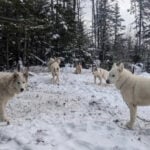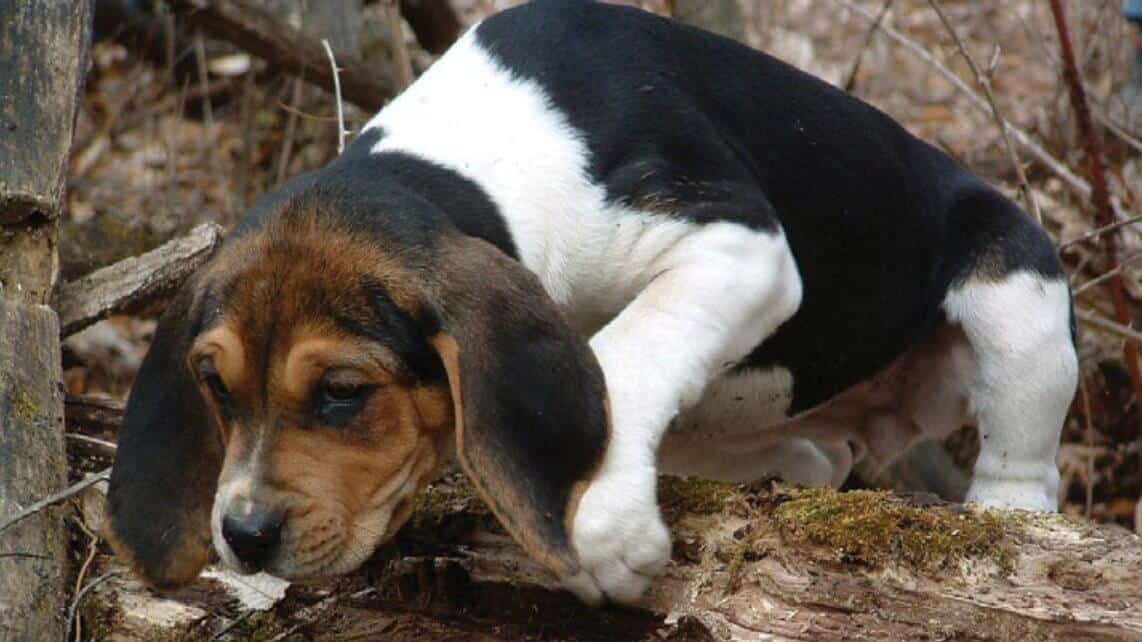


Home » Judging the Treeing Walker Coonhound

This article was originally published in Showsight Magazine, February 2014 issue.
Her name was Tim’s Creek Faith, a five-month-old frisky pup out of a nice Hardwood Echo female and sired by Tim’s Creek Bob. She wasn’t my first Treeing Walker Coonhound, but she was my first coonhound pup purchased with the express purpose of campaigning in licensed Nite Hunts. She was starting to figure out that raccoons climb trees and are fun to chase when I acquired her from Don Abernethy of Hickory, NC. I had known Don Abernethy my whole life—his father Harold owned a small convenience store, and I had gone to school with Don’s two daughters and son. Don’s wife, who often substitute-taught at my school, once even sent me to the principal’s office. Don was an avid Beagler turned coonhunter and an exceptional houndsman. To say he had a way with dogs is an understatement. Whether through experience or natural talent, Don always seemed to know the right thing to do with his coonhounds. Faith’s sire, Bob, was one of the best, if not the best, coonhound I’ve ever hunted with, and I was honored to get a pup by him. It wouldn’t be my last.
Faith had beautiful, rich colors and a friendly, tail-wagging personality. She lived for a pat on the head and the words, “Good job.” To pass the time at events, I trained and practiced with Faith for Bench Shows, which she could enter at six months old, while her Nite Hunt career was still months away. My show career began as a way to “do something” with my dog during the daylight hours. I learned a great deal while showing Faith, and for the first five shows, the main lesson was losing with grace. My step-brother Terry often accompanied me, and he would frequently be the one fuming at the end of judging. I was being “out-handled,” as they say, and had to improve.
My first competitive dog show win came not at a small event but at a larger Regional Qualifying Event in Seagrove, NC. These events qualify dogs for the World Coonhound Championship. At Seagrove, I showed Faith against top breeders and handlers and won Best Female of Show honors. While waiting for the officials to fill out my win slip, I learned another valuable lesson. Max Summerlin and David Gardin, who were filling out slips, became my lifelong friends that day. Max handed me the slip and said, “This is your win slip, and this paper states that you are qualified for the World Show. It does not say that you should go to the World Show.” David, who had judged the show, would chuckle to himself. I must have had a quizzical look on my face because Max would go on and explain to me that while my dog was pretty and had won that day, she was not mature enough, nor the caliber of dog that could win at the World Show. Many would have been angry at these comments, and I would bet that had Facebook been around, these comments would have been shared with the world as well as the all too common statement, “That judge is on my DNS list.” Max would also ask me if I had ever been to the World Show and suggested that I do so as a means of learning more about the show side of the sport as well as the dogs. This advice has always stayed with me and makes more sense to me with every weekend trip. I would follow that advice and began attending the shows at all the major Treeing Walker events. It was eye-opening in many ways and it would allow me to meet new people and to lay a foundation of knowledge for my future breeding plans.
The Treeing Walker is first and foremost a performance breed. From its foundation in the Kentucky foxhounds forward it has been bred for speed and endurance. As a raccoon treeing hound, it is challenged by no other breed in excellence. When judging, I observe these hounds from the moment they enter the show ring until my mind is made up. As they enter the ring, I look for an athlete. We use the term athlete all too often when describing hounds, but in the case of the Treeing Walker, it is most appropriate. The Treeing Walker is a tight-made hound, just off square, well-muscled with the look of speed. Not the racy look of the Whippet, but with a look that says I cover large amounts of ground quickly. We have a saying when describing the Treeing Walker: it is a go-yonder, get-deep, and get-treed type of coonhound. When evaluating the breed, picture this in your mind. It is dark. You are standing at the edge of a freshly harvested cornfield, and the tree line is 200 yards away. You point your Treeing Walker towards the woods and unleash it. It leaves in a dead sprint. In a few seconds, it is to the tree line. It opens soon on track, trails for a while longer, and suddenly locates and trees straight away in the woods where you cast. A quick look at your watch shows that a total of 30 seconds has elapsed, and a glance at your Garmin tracker will show that the dog is 800 yards away. That is the type of animal you are judging. This is a dog that was released, found a track, and trailed that track to completion a half mile away in about 30 seconds. That is the athlete I am trying to describe.
As the handlers stack the Treeing Walker, you should see a dog with its head level, ears relaxed, and a slender, moderate neck falling to well-laid-back shoulders. The front legs should be balanced substantially with the overall size of the dog and should drop straight down from the shoulder, landing on thick, well-padded, well-arched cat feet. A palm full of forechest is not as heavily boned as the English Foxhound, nor is it as racy as the American Foxhound. From the withers, the strong topline should gradually drop to the hips. The tail is set just below the hips. High or low tail set is undesirable. The Treeing Walker does not have a swayed or roached back. It is a moderate breed with no one part defining it. The rear end of the Treeing Walker should have moderate angulation, good turn of stifle, straight, short hocks, and again, cat feet. The rump should be muscular, as it is what propels this dog through the woods at night. When I see the Treeing Walker stacked, it reminds me of a dragster waiting on the tree to turn green. Like a great sports car, the Treeing Walker should look fast while standing still.
The finer points of the Treeing Walker headpiece are what set it apart from its foxhound forefathers. When compared to the American Foxhound, the Treeing Walker head should have a houndier, heavier appearance, with more depth of muzzle, slightly more flew, and a heavier brow bone. It has a soft, almost “beaglish” expression that masks the competitive nature of this breed. It should never have a hard look for expression. Dark brown eyes and soft-textured ears that roll to the front complete this beautiful face. All pigmentation on the Treeing Walker is black. No excessive dewlap—this is not a sloppy-looking hound—and the underline should start with a deep chest and gradually rise to the loin. The Treeing Walker lacks the regal look of the Black & Tan or the Bluetick and instead has a working man look to it.
The standard calls for tri-colored to be preferred over the two-colored variety. This harkens back to the days when Walkers were registered as English Fox and Coonhounds in the early 1900s. As the breed split, the color would separate these breeds. The American English Coonhound is primarily a two-color breed with the rare tri-color. The Treeing Walker is primarily a three-colored breed with the rare two-colored dogs. Black, White, and Tan or White, Black, and Tan are the preferred patterns, with the predominant amounts of each in order. The two-colored variety will have white and black. I look for a deep, rich red, lustrous black, and clean, tick-free vibrant white. Ticking is also a hallmark of the American English breed and is undesirable in the Treeing Walker.
I send the dogs around the ring, and again I am looking for the athletic dog that is light on its feet, showing good reach and drive but not excessive lift in the front nor kick in the rear. No wasted effort, as this is an efficient-moving breed. Sickle hocks are a fault and a weakness. The outline of the dog never changes during this movement. It maintains its topline, head carriage, and tail carriage. The tail is carried up like a saber. There is a hint of power to the movement but not of exertion. Footfalls are well-placed, and the parts are all in balance with each other. The dog comes to a halt, and the handler stacks him for inspection.
As I approach a Treeing Walker, I expect to see no shyness or timidity. I understand that the breed is shown on benches in many venues, and I realize that a judge standing over them may be new, but I expect them to cope with this with minimal fuss. This is a tail-wagging, friendly breed and should not be fearful of people. I go over the dog, and it is a strong animal with no weaknesses. I send it on its down and back. As it leaves me, it is not cow-hocked or sickle-hocked at all, as these are both faults. From an engineering standpoint, the hocks are where the most torque is applied, and any weakness there will be the first to break. Its rear legs do converge somewhat, although it may or may not single-track. On the return, I want to see the front legs do the same, and again, they may or may not single-track. They do fall in line and are not flipping to the side. Again, the tail is carried up. I send the hound around again and greet the handler with a ribbon at the table. Another Treeing Walker breed winner.
In summary, the Treeing Walker is a well-balanced, athletic dog that is powerful and graceful at the same time. It has a look of great speed and power without the raciness of the Greyhound or the substance of the Bloodhound. It has the soft expression of the Beagle and loves to please its owner. It is a competitive breed, and the dogs should have that competitive look to them while showing. It has effortless movement that has the look of power but not of exertion. The overall breed type is between that of the American Foxhound and the English Foxhound. Think of it as a bigger, houndier Harrier. I have attended many breed seminars over the years, and I have found that the majority of spokespeople promote picking breed type over conformation. I have heard Harry Miller on occasion say the following: Make your picks on breed type and then reward on conformation. I tend to agree with that thought process, and I explain it in this way: I can bring a Dalmatian into the ring, and it can have a perfect front, a perfect rear, and it moves around the ring in perfection. It is still not a Treeing Walker, though. I also realize that part of a performance breed’s type has to be correct structure, so I truly feel a balance in my selection process has to be achieved if I am to select the correct Treeing Walker time and again. Good luck in your future judging assignments.